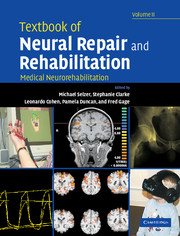Book contents
- Frontmatter
- Contents
- Preface
- Contributors
- Contributors
- Neural repair and rehabilitation: an introduction
- Section A Technology of neurorehabilitation
- Section A1 Outcomes measurement and diagnostic technology
- Section A2 Therapeutic technology
- Section B Symptom-specific neurorehabilitation
- Section B1 Sensory and motor dysfunctions
- Section B2 Vegetative and autonomic dysfunctions
- Section B3 Cognitive neurorehabilitation
- Section C Disease-specific neurorehabilitation systems
- 32 The organization of neurorehabilitation services: the rehabilitation team and the economics of neurorehabilitation
- 33 Traumatic brain injury
- 34 Neurorehabilitation in epilepsy
- 35 Parkinson's disease and other movement disorders
- 36 Neurorehabilitation of the stroke survivor
- 37 Rehabilitation in spinal cord injury
- 38 Multiple sclerosis
- 39 Cerebral palsy and paediatric neurorehabilitation
- 40 Neuromuscular rehabilitation: diseases of the motor neuron, peripheral nerve and neuromuscular junction
- 41 Muscular dystrophy and other myopathies
- Index
- Plate section
37 - Rehabilitation in spinal cord injury
from Section C - Disease-specific neurorehabilitation systems
Published online by Cambridge University Press: 04 August 2010
- Frontmatter
- Contents
- Preface
- Contributors
- Contributors
- Neural repair and rehabilitation: an introduction
- Section A Technology of neurorehabilitation
- Section A1 Outcomes measurement and diagnostic technology
- Section A2 Therapeutic technology
- Section B Symptom-specific neurorehabilitation
- Section B1 Sensory and motor dysfunctions
- Section B2 Vegetative and autonomic dysfunctions
- Section B3 Cognitive neurorehabilitation
- Section C Disease-specific neurorehabilitation systems
- 32 The organization of neurorehabilitation services: the rehabilitation team and the economics of neurorehabilitation
- 33 Traumatic brain injury
- 34 Neurorehabilitation in epilepsy
- 35 Parkinson's disease and other movement disorders
- 36 Neurorehabilitation of the stroke survivor
- 37 Rehabilitation in spinal cord injury
- 38 Multiple sclerosis
- 39 Cerebral palsy and paediatric neurorehabilitation
- 40 Neuromuscular rehabilitation: diseases of the motor neuron, peripheral nerve and neuromuscular junction
- 41 Muscular dystrophy and other myopathies
- Index
- Plate section
Summary
Epidemiology of traumatic spinal cord injury
The worldwide incidence of spinal cord injury (SCI) is estimated to be 40 cases per million annually (Sekhon and Fehlings, 2001; National SCI Statistical Center, 2004). In the USA the incidence is approximately 11,000 new cases each year with an additional 4000 cases that do not survive injury long enough to reach a hospital. Prevalence data are less well substantiated due to variability in the severity criteria used to select cases. The estimated number of persons with SCI in the USA is 247,000 (National SCI Statistical Center, 2004).
The National SCI Statistical Center has collected data on approximately 13% of new cases of SCI since 1973. These data (National SCI Statistical Center, 2004) indicate that SCI primarily affects young males (average age at injury is 38 years, 78.2% males). However, with the aging of the USA population, there has been an increase in the proportion of people 60 or more years old at time of injury (4.7% prior to 1980 and 10.9% since 2000). While slightly over half of people with SCI have tetraplegia (56.4%), the proportion of injuries resulting in complete tetraplegia is decreasing and the proportion with incomplete tetraplegia and paraplegia is increasing. Average life expectancy for people with SCI is rising, although actual life expectancy varies with level and completeness of injury as well as age at time of injury.
Keywords
- Type
- Chapter
- Information
- Textbook of Neural Repair and Rehabilitation , pp. 593 - 615Publisher: Cambridge University PressPrint publication year: 2006

